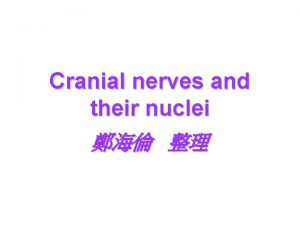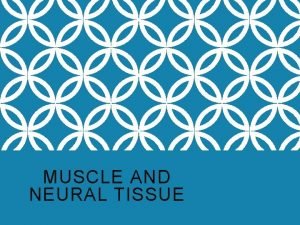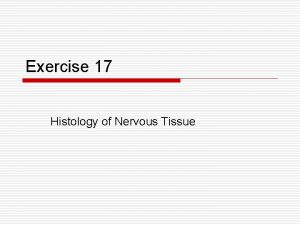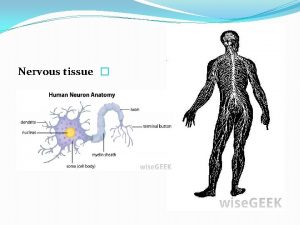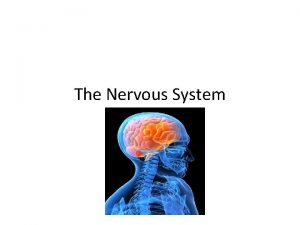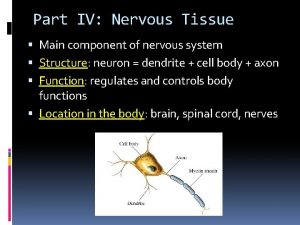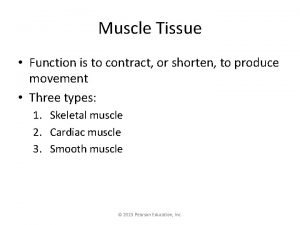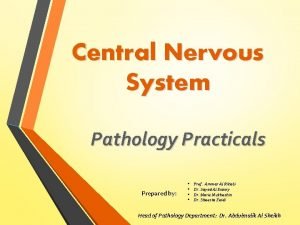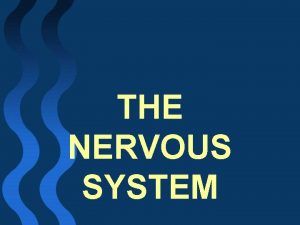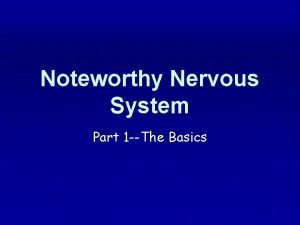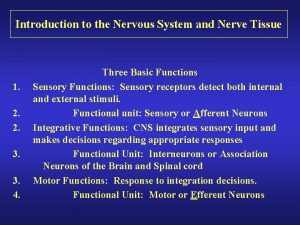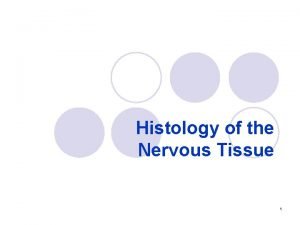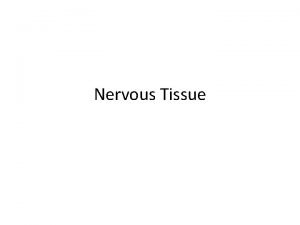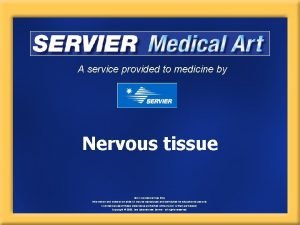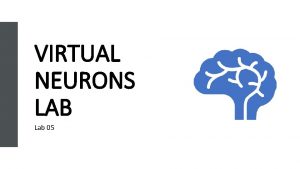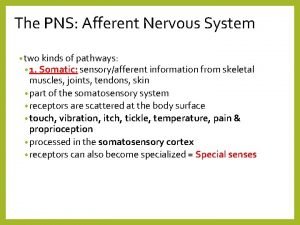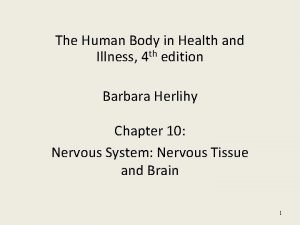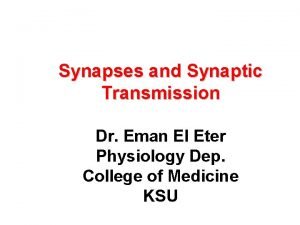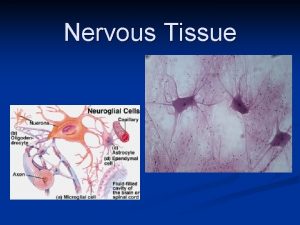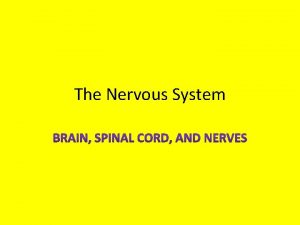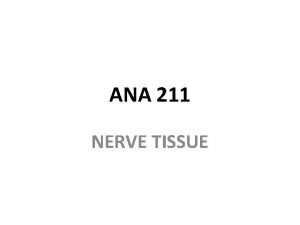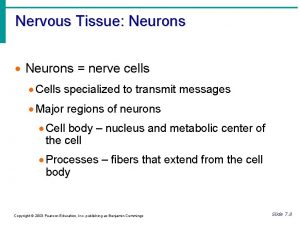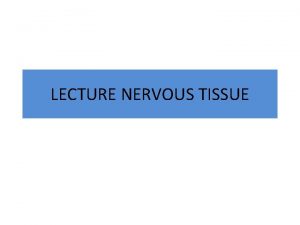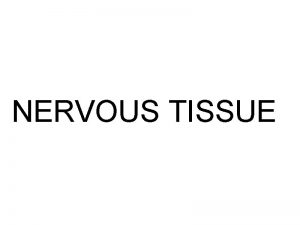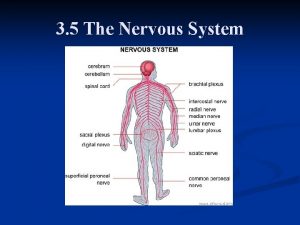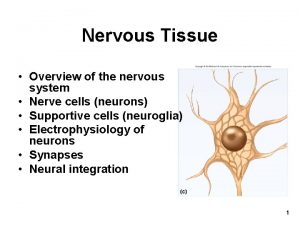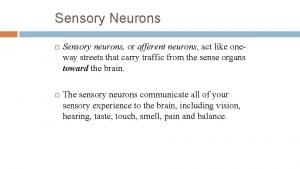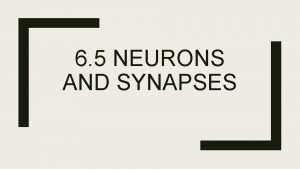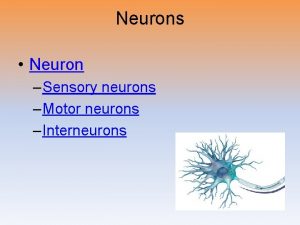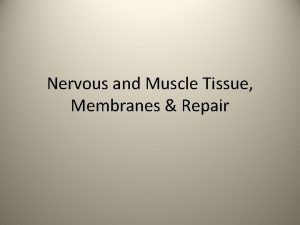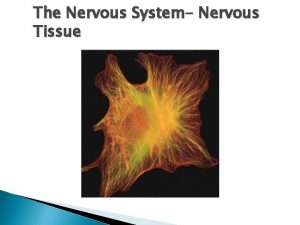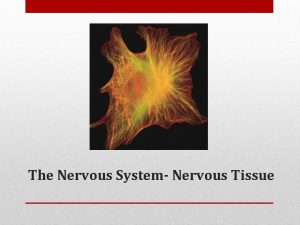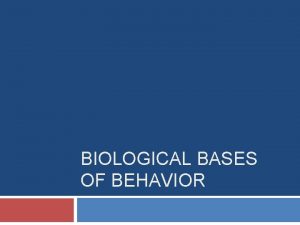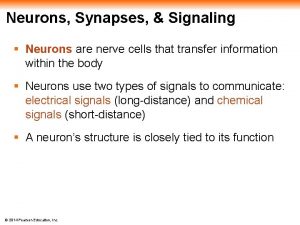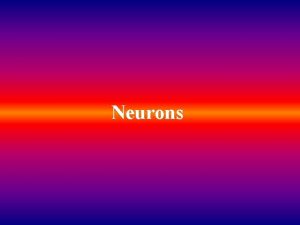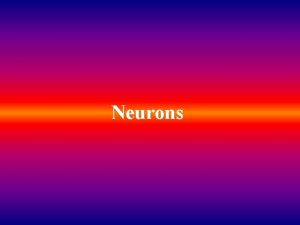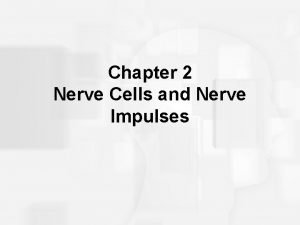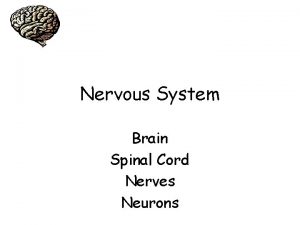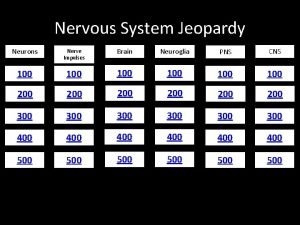The Nervous System Nervous Tissue 1 Neurons nerve































- Slides: 31

The Nervous System

Nervous Tissue 1. Neurons (nerve cells) - transmit message Anatomy: ▫ ▫ ▫ Cell body – contains nucleus; metabolic center Dendrite – fiber that conveys messages toward cell body Axon – conduct nerve impulses away from the cell body Axon terminals – end of axon; contain neurotransmitters & release them Synaptic cleft/synapse – gap between neurons

• • Myelin: whitish, fatty material that covers nerve fibers to speed up nerve impulses Schwann cells: surround axons and form myelin sheath Myelin sheath: tight coil of wrapped membranes Nodes of Ranvier: Ranvier gaps between Schwann cells


• • Ganglia: Ganglia collections of cell bodies Bundles of nerve fibers = tracts (CNS) or nerves (PNS) White matter: matter dense collections of myelinated fibers Gray matter: matter unmyelinated fibers & cell bodies

Nervous Tissue 2. Supporting cells (Neuroglia) Neuroglia CNS: astrocytes, microglia, ependymal cells, oligodendrocytes barrier between capillaries and neurons protect neurons immune/defense line brain and spinal cord cavities wrap nerve fibers produces myelin sheaths (covering) PNS: Schwann cells, satellite cells surround large neurons protect & cushion


Classification of Neurons

1. Functional Classification: direction nerve impulse is traveling Sensory neurons Motor neurons Interneurons carry impulses from sensory receptors to CNS carry impulses from CNS to muscles & glands connect sensory & motor neurons Vision, hearing, equilibrium, taste, smell, pain, pressure, heat


2. Structural Classification: # processes extending from cell body Multipolar Bipolar Unipolar 1 axon, several dendrites 1 axon, 1 dendrite 1 process Rare Short with 2 branches (sensory, CNS) Most common (99%) Eg. Motor neurons, Eg. retina, nose, ear interneurons Eg. PNS ganglia


Nerve Impulses

Neuron Function 1. Irritability: Irritability to respond to stimulus & convert to nerve impulse 2. Conductivity: Conductivity transmit impulse to other neurons, muscles, or glands

Exciting a Neuron: • Cell membrane at rest = polarized ▫ Na+ outside cell, K+ inside cell ▫ Inside is (-) compared to outside • Stimulus excited neuron (Na+ rushes in) becomes depolarized • Depolarization activates neuron to transmit an action potential (nerve impulse) ▫ All-or-none response ▫ Impulse conducts down entire axon • K+ diffuses out repolarization of membrane • Na+/K+ ion concentrations restored by sodiumpotassium pump (uses ATP)

Resting membrane potential (-70 m. V)

Gated Ion Channels (Na+ and K+)

Depolarization



• Saltatory conduction: conduction electrical signal jumps from node to node along myelinated axon (30 x faster!)

Multiple Sclerosis (MS) • Autoimmune disease • Myelin sheaths destroyed reduced to hardened lesions (scleroses) • Blindness, muscle weakness, speech disturbance, urinary incontinence • Treatment: interferons, glatiramer (hold off attacks)


Nerve Conduction • Action potential reaches axon terminal vesicles release neurotransmitters (NT) into synaptic cleft • NT diffuse across synapse bind to receptors of next neuron • Transmission of a nerve impulse = electrochemical event

Neurotransmitters • • 50+ identified Excitatory: Excitatory cause depolarization Inhibitory: Inhibitory reduce ability to cause action potential Eg. acetylcholine, serotonin, endorphins

Neurotransmitters Neurotransmitter Action Affected by: Acetylcholine muscle contraction botulism, curare (paralytic), nicotine Dopamine “feeling good” cocaine, amphetamines Serotonin sleep, appetite, nausea, mood, migraines Prozac, LSD, ecstasy Endorphins inhibit pain morphine, heroin, methadone GABA main inhibitory NT alcohol, Valium, barbiturates


Reflexes • Rapid, predictable, involuntary responses to stimuli 1. Somatic Reflexes: stimulate skeletal muscles ▫ Eg. jerking away hand from hot object 2. Autonomic Reflexes: regulate smooth muscles, heart, glands ▫ Eg. salivation, digestion, blood pressure, sweating

Reflex Arc (neural pathway) Five elements: 1. Receptor – reacts to stimulus 2. Sensory neuron 3. CNS integration center 4. Motor neuron 5. Effector organ – muscle or gland


 Neuronal pool
Neuronal pool Sensory input and motor output
Sensory input and motor output Nerve cell processes
Nerve cell processes Trigeminal nerve which cranial nerve
Trigeminal nerve which cranial nerve Nerve tissue description
Nerve tissue description What are the characteristics of nervous tissue
What are the characteristics of nervous tissue Cns histology ppt
Cns histology ppt Exercise 17 gross anatomy of the brain and cranial nerves
Exercise 17 gross anatomy of the brain and cranial nerves Classify nervous tissue
Classify nervous tissue Nervous tissue in the lungs
Nervous tissue in the lungs Nervous tissue in brain
Nervous tissue in brain Smooth muscle
Smooth muscle Glioblastoma multiforme
Glioblastoma multiforme Nervous tissue
Nervous tissue Nervous tissue diagram
Nervous tissue diagram Nervous tissue
Nervous tissue Building vocabulary activity: the central nervous system
Building vocabulary activity: the central nervous system Diagram of nervous tissue
Diagram of nervous tissue Nervous tissue definition
Nervous tissue definition Nervous tissue
Nervous tissue Nervous tissue
Nervous tissue Perforation plates
Perforation plates Nervous system and digestive system
Nervous system and digestive system Endocrine system vs nervous system
Endocrine system vs nervous system Nervous system vs endocrine system venn diagram
Nervous system vs endocrine system venn diagram Endocrine system
Endocrine system Virtual neurons
Virtual neurons Proprioceptors
Proprioceptors Homunculus
Homunculus 1st order 2nd order 3rd order neurons
1st order 2nd order 3rd order neurons Divergence neurons
Divergence neurons Input neurons
Input neurons



